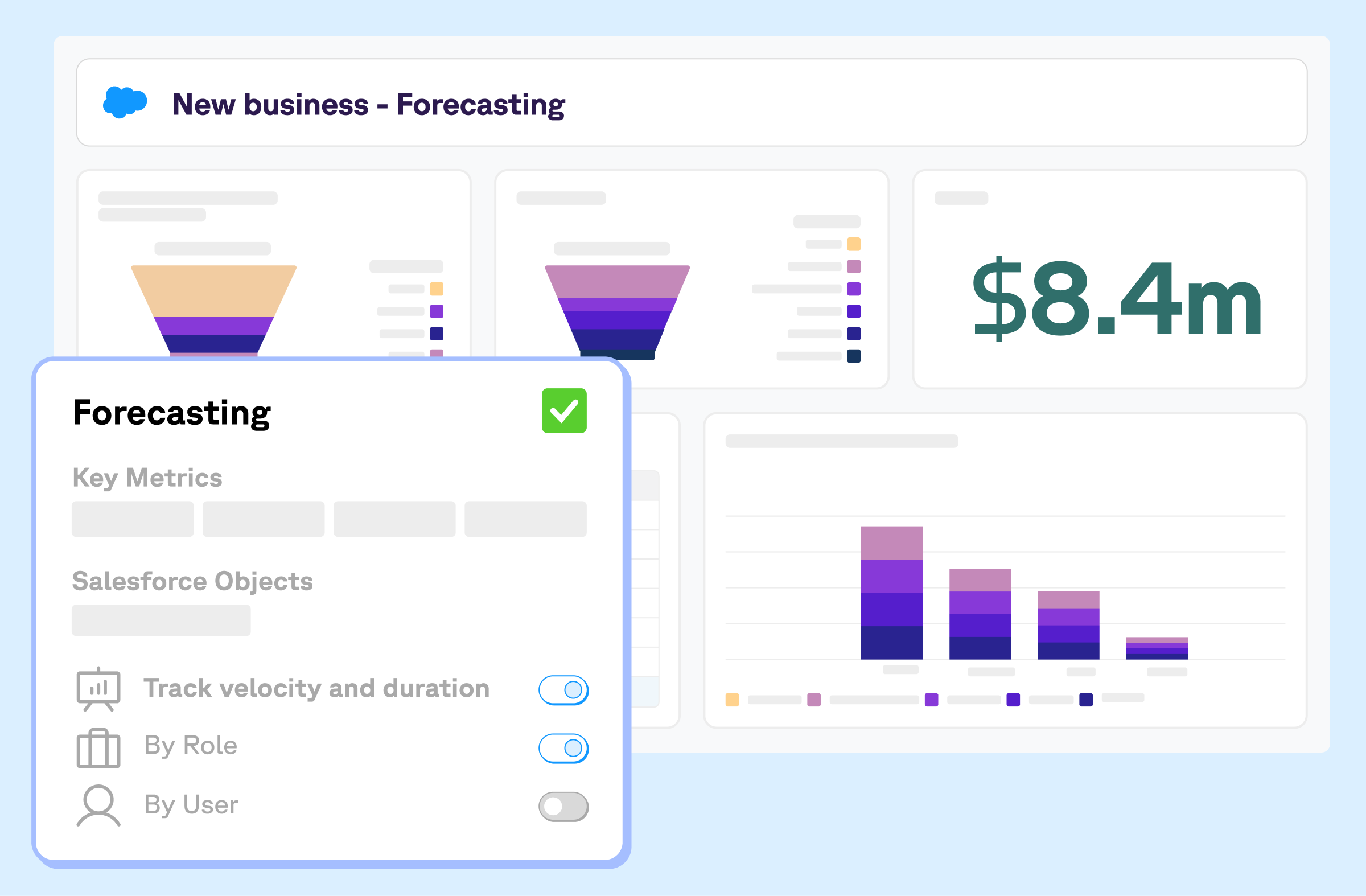
Before you can determine how well your team is performing, you have to set up a measurement system. Sales metrics provide valuable insights into sales performance, enable goal setting and accountability, support decision-making, drive continuous improvement, and facilitate performance benchmarking. They are essential for managing and optimizing sales efforts, aligning sales strategies with organizational objectives, and driving revenue growth. Plus, they will help you set KPIs (Key Performance Indicators) for your sales team as well as the business overall.
But just looking at dashboards is not enough. In order to evaluate the health of your business, you have to know what you’re looking at and why it’s important. As a revenue leader, it’s vital that you have a strong understanding of your team’s sales metrics and KPIs. In this article, we’ll explain how to select the right metrics to track and how to build out KPIs so that you can set the revenue standard for your organization.
What key sales metrics do I need to track?
Determining the most important sales metrics and key performance indicators (KPIs) depends on the specific business and team goals. It is essential to align the metrics for sales with strategic growth initiatives. For example, if the aim is to target the enterprise market, tracking average deal size and average revenue per unit can indicate progress in securing larger deals from larger customers. If the goal is for all reps to meet their quotas, activity metrics and performance indicators like emails sent, phone calls made, and meetings booked can be crucial. Similarly, for scaling commercial or SMB markets, reducing the sales cycle length while increasing average revenue per unit might be a focus.
Examples of key sales metrics
The choice of metrics depends on the unique objectives of each business and should align with the desired revenue goals. Here are some examples of sales metrics recommended for any revenue team:
- Annual Recurring Revenue (ARR): ARR represents the total contracted revenue a company generates in a year, and it is particularly crucial for any SaaS business operating on a subscription model. It serves as a vital key performance indicator (KPI) by providing insights into the anticipated revenue from customers over a fiscal year. By analyzing historical data, ARR becomes a valuable tool for assessing company growth and aiding in long-term projections.
- Average Revenue Per User (ARPU): ARPU or ARPA measures the average revenue generated per subscriber or account, providing insights into revenue stability and customer segments. Average revenue per user (ARPU) or average revenue per account (ARPA) refers to the amount of money that a company brings in per subscriber, user, or account in a particular time period. If your ARPU is increasing, it's an indicator that your revenue is holding value, making it an important KPI to track. Plus, determining your highest ARPU customers may also give you an idea of your best product-market fit.
- Quota Attainment: When it comes to sales forecasting, Quota Attainment can be an incredibly useful metric. It measures the percentage of closed deals or revenue achieved in relation to the assigned quota. It also helps management identify reps who might benefit from more coaching or guidance, or alternatively, who is performing exceptionally.
- Win rate: Win Rate tracks the percentage of closed-won deals, indicating sales reps' performance and pipeline coverage requirements. Tracking how the win rate changes over time can help you evaluate your sales reps' performance as well as how much sales pipeline coverage you need to hit your sales targets.
- Conversion rate: Conversion Rate measures the success rate of turning qualified leads into closed deals, improving lead quality and alignment between sales and marketing teams. This helps measure your sales team’s efficiency in turning leads into customers.
- Sales cycle length: Sales Cycle Length measures the average time it takes to convert an opportunity into a closed deal, identifying bottlenecks and improving efficiency.
- Average deal size: Average Deal Size measures the average dollar amount per closed deal, reflecting sales teams' ability to secure larger deals.
- Average profit margin: Average profit margin evaluates overall business performance by comparing net income to net sales.
- Deal slippage: Deal slippage tracks deals that are forecasted for a specific period but get delayed or pushed into a different time frame. Note: every company must contend with deal slippage. However, by tracking it, your team will be in a better position to predict revenue.
- Churn rate: Churn rate quantifies the number of customers who cancel or do not renew subscriptions, highlighting customer retention challenges. Again, this metric will exist at any subscription-based company. And while it’s not the most positive number, it’s crucial to track in order to evaluate whether the business is growing or not.
- Net retention percentage: Net retention percentage calculates the growth or contraction of revenue from existing customers by considering renewals, upsells, and churn.
- Pipeline coverage: Pipeline coverage assesses the number of opportunities in the sales pipeline to ensure sales targets are met.
- Sales productivity metrics: Sales productivity metrics track sales activity data to assess prospect engagement and improve sales performance.
- Sales linearity: Sales linearity ensures a consistent pattern of closing. This target usually removes the need for deep discounts at the end of the quarter and allows for more predictable revenue. Plus, it can contribute to better cash flow.
Of course, these are just common sales metrics to get you started. You will still need to determine the sales metrics and KPIs that are most relevant to your business so you can work on building a system to keep track of them. Many businesses rely on a sales analyst – or analytics team – who is responsible for managing the data as well as interpreting it for the team.
If you’re using Salesforce as your CRM, you may want to use a tool like Sweep to help gain visibility into your sales data. Sweep is a no-code configuration tool designed to help B2B companies customize and scale the way their teams are using Salesforce, without the dev time.
It also allows you to generate reports for any and all of the elements of your sales funnel so you can pull the performance data when you need it.
Using sales analysis for sales performance metrics
Having an analyst on your team can be invaluable to your sales team. After all, simply tracking sales performance metrics is not going to help you grow, scale, or optimize your business. It’s important to understand what story the data is telling to you. Once the analysts have access to the data, they can provide valuable insights that can enhance the performance, productivity, and effectiveness of a sales team.

How to measure sales performance
Depending on your particular business needs, the analytics team can examine various sales performance metrics, such as individual sales reps' productivity, revenue-critical employees, accurate sales forecasting, and overall sales processes. By leveraging sales analytics, sales managers can identify the strengths and weaknesses of their team members and revenue contributors, enabling them to make necessary adjustments to behaviors and sales strategies for achieving success.
Sales managers can also use the analysts to help them identify opportunities for targeted coaching for their sales reps. By basing conversations on data instead of subjective opinions, sales managers can provide more effective guidance and support to their team members.
Revenue leaders can rely on sales analytics to provide visibility and insights into the larger sales trends occurring within sales cycles. It helps uncover any issues, such as longer deal closure times or declining average contract values, and enables them to steer the team back on track.
How do I set KPIs for the sales team?
Setting Key Performance Indicators (KPIs) for your sales team involves a systematic approach to ensure alignment with your business goals and objectives. Keep in mind that KPIs can change over time, depending on updates with the business, shifts in the economy, and the addition (or subtraction) of specific product offerings. Working alongside your sales team and your sales analytics team will help you evaluate when KPIs need to change. Here are the steps to set effective KPIs for your sales team:
1. Define your objectives:
Clearly establish your business objectives and sales goals. Determine what you want to achieve, such as increasing revenue, acquiring new customers, improving customer retention, or expanding into new markets.
2. Identify measurable metrics:
Identify the specific metrics that will help you track progress towards your objectives. These metrics can include sales revenue, customer acquisition rate, conversion rate, average deal size, customer lifetime value, sales cycle length, or any other relevant sales performance indicators.
3. Align with your team:
Involve your sales team in the goal-setting process to ensure buy-in and commitment. Seek input from team members and sales managers to understand their perspectives and gather insights.
4. Set SMART KPIs:
Ensure that your KPIs are Specific, Measurable, Achievable, Relevant, and Time-bound (SMART). Each KPI should be well-defined, quantifiable, realistic, aligned with your objectives, and have a specific timeframe for evaluation.
5. Establish benchmarks and targets:
Set benchmarks or targets for each KPI to provide a clear performance expectation. Consider historical data, industry standards, and your desired growth rate when setting these benchmarks.
6. Regularly review and track progress:
Continuously monitor and review the performance of your sales team against the defined KPIs. Use analytics and reporting tools to track progress and identify areas for improvement.
7. Provide feedback and support:
Regularly provide feedback to your sales team based on the KPI results. Recognize achievements, address performance gaps, and provide necessary support and resources to help them meet their targets.
8. Adjust and refine:
Periodically review and reassess your KPIs to ensure they remain relevant and aligned with your evolving business goals. Modify or refine them as needed based on changing market conditions, business priorities, or feedback from your team.
Remember, KPIs should be motivating, actionable, and provide a clear direction to your sales team. Regular communication, coaching, and support are essential to ensure your team understands the KPIs, feels engaged, and works towards achieving them.
Want to learn more about how Sweep can help you manage and track your sales metrics and KPIs? Book a demo with one of our team members today.











